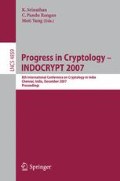Abstract
Transitive signature is an interesting primitive due to Micali and Rivest. During the past years, many constructions of transitive signatures have been proposed based on various assumptions. In this paper, we provide the first construction of transitive signature schemes by using braid groups. In the random oracle model, our proposals are proved to be transitively unforgeable against adaptively chosen message attack under the assumption of the intractability of one-more matching conjugate problem (OM-MCP) over braid groups. Moreover, the proposed schemes are invulnerable to currently known quantum attacks.
Access this chapter
Tax calculation will be finalised at checkout
Purchases are for personal use only
Preview
Unable to display preview. Download preview PDF.
References
Anshel, I., Anshel, M., Fisher, B., Goldfeld, D.: New Key Agreement Protocols in Braid Group Cryptography. In: Naccache, D. (ed.) CT-RSA 2001. LNCS, vol. 2020, pp. 13–27. Springer, Heidelberg (2001)
Anshel, I., Anshel, M., Goldfeld, D.: An algebraic method for public-key cryptography. Math. Research Letters 6, 287–291 (1999)
Anshel, M.: Braid Group Cryptography and Quantum Cryptoanalysis. In: 8th International Wigner Symposium, May 27-30, 2003, GSUC-CUNY 365 Fifth Avenue, NY, NY 10016, USA (2003)
Bellare, M., Neven, G.: Transitive signaures based on factoring and RSA. In: Zheng, Y. (ed.) ASIACRYPT 2002. LNCS, vol. 2501, pp. 397–414. Springer, Heidelberg (2002)
Bellare, M., Neven, G.: Transitive signatures: New schemes and proofs. IEEE Transactions on Information Theory 51(6), 2133–2151 (2005)
Bellare, M., Namprempre, C., Pointcheval, D., Semanko, M.: The One-More-RSA-Inversion Problems and the Security of Chaum’s Blind Signature Scheme. Journal of Cryptology 16(3), 185–215 (2003)
Cha, J.C., Ko, K.H., Lee, S.J., Han, J.W., Cheon, J.H., et al.: An efficient implementation of braid groups. In: Boyd, C. (ed.) ASIACRYPT 2001. LNCS, vol. 2248, pp. 144–156. Springer, Heidelberg (2001)
Cheon, J.H., Jun, B.: A Polynomial Time Algorithm for the Braid Diffie-Hellman Conjugacy Problem. In: Boneh, D. (ed.) CRYPTO 2003. LNCS, vol. 2729, pp. 212–225. Springer, Heidelberg (2003)
Dehornoy, P.: Braid-based cryptography. Contemp. Math., Amer. Math. Soc. 360, 5–33 (2004)
Elrifai, E., Morton, H.R.: Algorithms for positive braids. Quart. J. Math. Oxford Ser. 45(2), 479–497 (1994)
Franco, N., Gonzales-Menses, J.: Conjugacy problem for braid groups and garside groups. Journal of Algebra 266, 112–132 (2003)
Gebhardt, V.: A new approach to the conjugacy problem in garside groups. Journal of Algebra 292, 282–302 (2005)
Gonzales-Meneses, J.: Improving an algorithm to solve the multiple simultaneous conjugacy problems in braid groups, Preprint, math.GT/0212150 (2002)
Huang, Z.-J., Hao, Y.-H., Wang, Y.-M., Chen, K.-F.: Efficient directed transitive signature scheme. Acta Electronica Sinica 33(8), 1497–1501 (2005)
Hughes, J.: The left SSS attack on Ko-Lee-Cheon-Han-Kang-Park key agreement scheme in B45, Rump session Crypto (2000)
Hughes, J.: A linear algebraic attack on the AAFG1 braid group cryptosystem. In: Batten, L.M., Seberry, J. (eds.) ACISP 2002. LNCS, vol. 2384, pp. 176–189. Springer, Heidelberg (2002)
Kitaev, A.: Quantum measurements and the abelian stabilizer problem. Preprint, quant-ph/9511026 (1995)
Ko, K.H., Choi, D.H., Cho, M.S., Lee, J.W.: New signature scheme using conjugacy problem (preprint 2002), http://eprint.iacr.org/2002/168
Ko, K.H., Lee, S.J., Cheon, J.H., Han, J.W.: New public-key cryptosystem using braid groups. In: Bellare, M. (ed.) CRYPTO 2000. LNCS, vol. 1880, pp. 166–183. Springer, Heidelberg (2000)
Ko, K.H., Lee, J.W., Thomas, T.: Towards generating secure keys for braid cryptography, Designs, Codes and Cryptography (to appear, 2007)
Kuwakado, H., Tanaka, H.: Transitive Signature Scheme for Directed Trees. IEICE Transactions on Fundamentals of Electronics, Communications and Computer Sciences E86-A(5), 1120–1126 (2003)
Lee, E.: Braig groups in cryptography. IEICE Trans. Fundamentals E87-A(5), 986–992 (2004)
Lee, E., Lee, S.-J., Hahn, S.-G.: Pseudorandomness from Braid Groups. In: Kilian, J. (ed.) CRYPTO 2001. LNCS, vol. 2139, pp. 486–502. Springer, Heidelberg (2001)
Magliveras, S., Stinson, D., van Trung, T.: New approaches to designing public key cryptosystems using one-way functions and trapdoors in finite groups. Journal of Cryptography 15, 285–297 (2002)
Micali, S., Rivest, R.L.: Transitive signaure schemes. In: Preneel, B. (ed.) CT-RSA 2002. LNCS, vol. 2271, pp. 236–243. Springer, Heidelberg (2002)
Myasnikov, A., Shpilrain, V., Ushakov, A., Practical, A.: Attack on a Braid Group Based Cryptographic Protocol. In: Shoup, V. (ed.) CRYPTO 2005. LNCS, vol. 3621, pp. 86–96. Springer, Heidelberg (2005)
Proos, J., Zalka, C.: Shors discrete logarithm quantum algorithm for elliptic curves. Quantum Information and Computation 3, 317–344 (2003)
Shahandashti, S.F., Salmasizadeh, M., Mohajeri, J.: A provably secure short transitive signature scheme from bilinear group Pairs. In: Blundo, C., Cimato, S. (eds.) SCN 2004. LNCS, vol. 3352, pp. 60–76. Springer, Heidelberg (2005)
Shor, P.: Polynomail-time algorithms for prime factorization and discrete logarithms on a quantum computer. SIAM J. Comput. 5, 1484–1509 (1997)
Wang, L.: PhD. Disseration. Shanghai Jiao Tong University (June 2007)
Wang, L., Cao, Z., Zeng, P., Li, X.: One-more matching conjugate problem and security of braid-based signatures. In: ASIACCS 2007, pp. 295–301. ACM, New York (2007)
Warren Jr., Henry, S.: A modification of Warshall’s algorithm for the transitive closure of binary relations. Communications of the ACM 18(4), 218–220 (1975)
Yi, X.: Directed transitive signature scheme. In: Abe, M. (ed.) CT-RSA 2007. LNCS, vol. 4377, pp. 129–144. Springer, Heidelberg (2006)
Yi, X., Tan, C.-H., Okamoto, E.: Security of Kuwakado-Tanaka transitive signature scheme for directed trees. IEICE Transactions on Fundamentals of Electronics, Communications and Computer Sciences E87-A(4), 955–957 (2004)
Zhu, H.: Model for undirected transitive signatures. IEE Proceedings: Communications 151(4), 312–315 (2004)
Author information
Authors and Affiliations
Editor information
Rights and permissions
Copyright information
© 2007 Springer-Verlag Berlin Heidelberg
About this paper
Cite this paper
Wang, L., Cao, Z., Zheng, S., Huang, X., Yang, Y. (2007). Transitive Signatures from Braid Groups. In: Srinathan, K., Rangan, C.P., Yung, M. (eds) Progress in Cryptology – INDOCRYPT 2007. INDOCRYPT 2007. Lecture Notes in Computer Science, vol 4859. Springer, Berlin, Heidelberg. https://doi.org/10.1007/978-3-540-77026-8_14
Download citation
DOI: https://doi.org/10.1007/978-3-540-77026-8_14
Publisher Name: Springer, Berlin, Heidelberg
Print ISBN: 978-3-540-77025-1
Online ISBN: 978-3-540-77026-8
eBook Packages: Computer ScienceComputer Science (R0)

